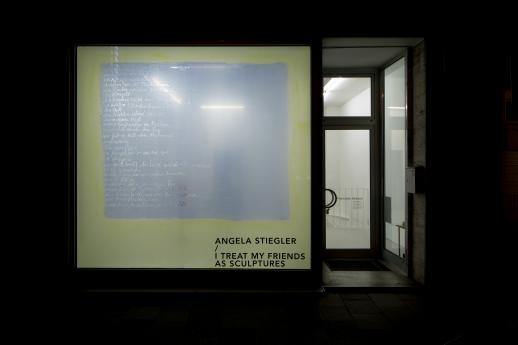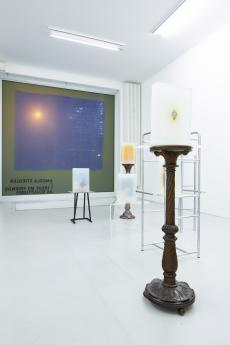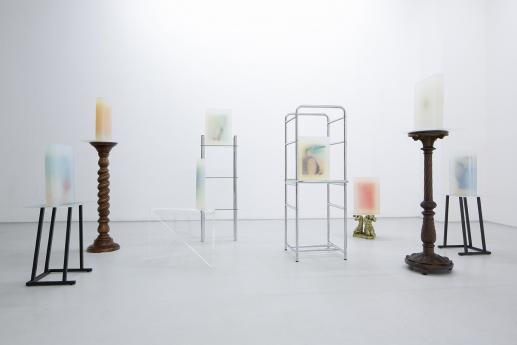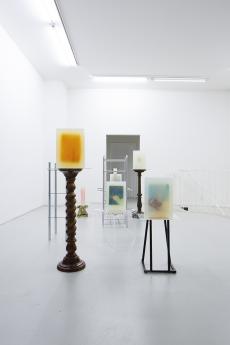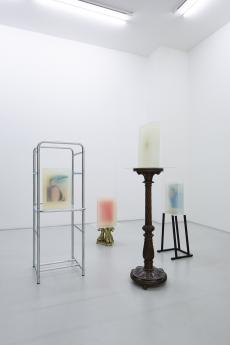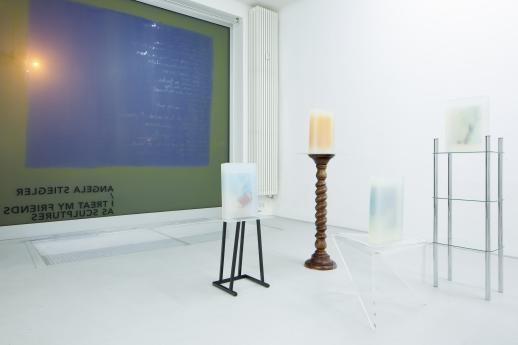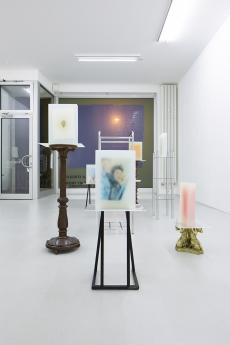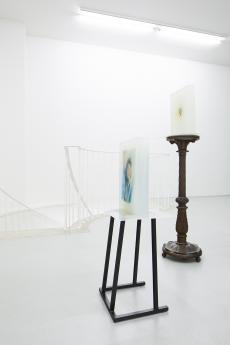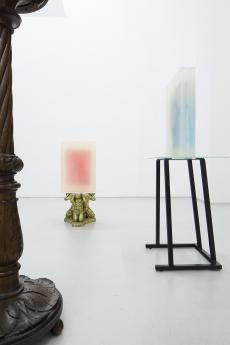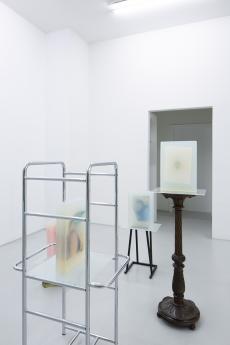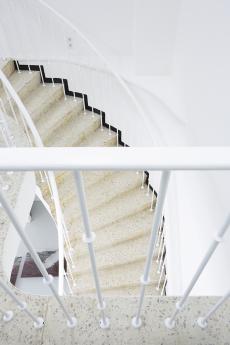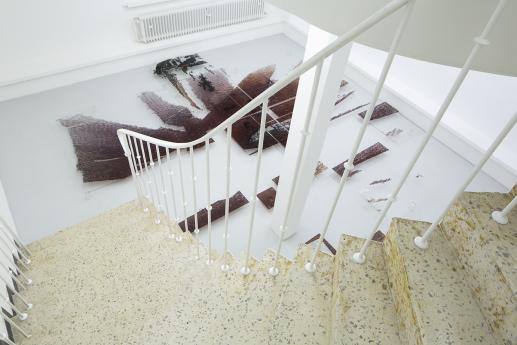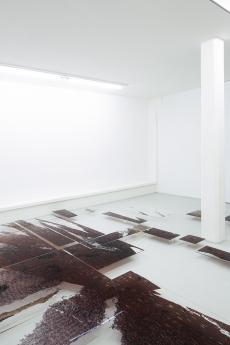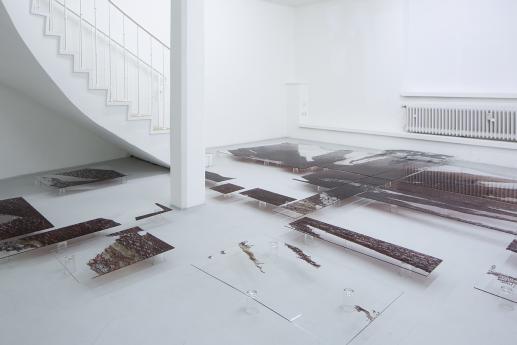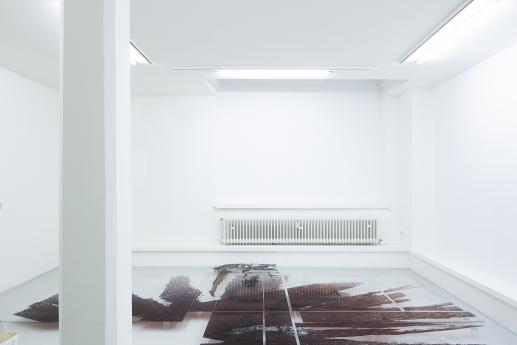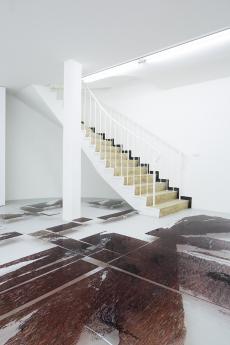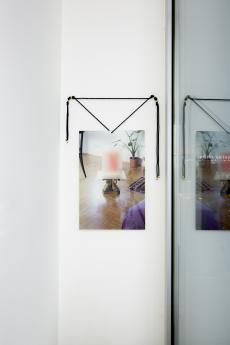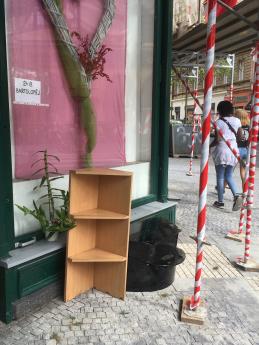ANGELA STIEGLER
/
I TREAT MY FRIENDS AS SCULPTURES
20.11.2020 - 20.02.2021
„A portrait of an artist as an ageless friend“, 2021, companion film, 05:12 min, video: Yulia Lokshina, text: Angela Stiegler, music: doctor dreamchip
Insister nannte Jacques Derrida seine langjährige Freundin, Gesprächspartnerin, Echokammer Hélène Cixous. Sie hatte für ihn auch irgendeinen Namen. Sie arbeiteten miteinander und übereinander. Im Spiegel der Arbeit des anderen. Du sagst gerne, dass 'bohemistische Forschung' einen ähnlichen Hintergrund in einem gemeinsamen Umfeld voraussetzt, eine spezifische individuelle Vielfalt, die aber doch auf eine geteilte Basis baut, auf ähnliche Probleme, ähnliche herausfordernde Erfahrung, die man überwinden oder auch erst mal nur greifen möchte. Für Derrida und Cixous galt das biographisch auf jeden Fall. Wir arbeiten oft miteinander, seltener übereinander.
Wobei ich ja immer wieder diese Aufnahmen von dir mache, die wir mit Vergnügen 'biopic' nennen, von denen aber niemand so genau weiß, was sie sollen, was dich aber auch gar nicht zu stören scheint. Du arbeitest schon lange mit deinem Umfeld, ganz direkt, vielleicht auch als eine Art In-sister, in einem familiären Verbund. Die Schwester und die Insistiererin, die Besteherin, die Verfechterin. In deiner Arbeit 'Anti Körper' wurde viel gekämpft, wobei der Kampf nicht auf Gewalt, sondern auf Kontakt gründete. Ein Konflikt basiert auf Nähe und nicht auf Fremdheit. Der Kampf prägte die ausgesprochen körperlich gehaltene Performance, aber auch alle Aushandlungsprozesse um ihre Entstehung an sieben aufeinanderfolgenden Tagen. Der Kampf als Kontakt. Du schützt eine größtmögliche Offenheit für Formen und Bedeutungen, die tatsächlich erst im Prozess ihren Platz finden dürfen und es auch tun, weil der Platz noch nicht besetzt ist. Die Insistiererin, die Tiererin, das Tier, um im Sinne Derridas die Identität als Behältnis aufzumachen. Im Austausch mit anderen entstehen Objekte und Praktiken, die oft erst im nächsten Schritt, wieder im Gespräch, im Kontakt, in Transformation, ihre Funktion finden. Die Arbeiten entwickeln sich in einem Biotop mit 'companions', die keine klar abgegrenzten oder zugewiesenen Rollen haben. Sie stehen nie alleine und suchen fortwährend nach Begleitung. Es ist ein molekulares Interesse an diesen 'companions', an den Freund:innen, die in Form von Punktwolken, auf Papier oder in Seife, als Antikörper die Arbeiten durchziehen.
Seife ist weniger giftig als Epoxidharz, sie ist billiger als Polyurethan, sie ist transparent, sie entfernt Bakterien. Sie geht einen Kampf ein. Das Verschwinden, die Auflösung, die stille Aggressivität der Seife macht Angst und in dieser Angst stehen die acht schwerbeweglichen Kilos auf ihren Sockeln, die objektgewordenen Kämpfe. Sie führen ein leises Eigenleben, in dem die feinen Farbpartikel zwar eingeschlossen sind, sich aber zugleich in einem ständigen unkontrollierbaren Wandel befinden. So findet sich auf den Sockeln eigentlich ein Prozess, der sich gewissermaßen nur als Objekt maskiert. Die Sockel sind eine Erhöhung und damit auch eine Überhöhung der Idee einer Abgeschlossenheit. Die Seife hat so gesehen keinen Aggregatzustand, ihre Aufgabe ist es, im Gebrauch zu verschwinden. Der darin wohnende unabgeschlossene Prozess lässt sich trotz aller Fixierung nicht mehr kontrollieren und jedes Eingreifen oder Eindringen würde eine grundlegende Veränderung der Form bedeuten. Die ebenso schwer kontrollierbaren Beziehungsprozesse werden zu Skulpturen und bringen sich wiederum selbst formgebend in diese Arbeit ein. Nicht nur du behandelst deine Freund:innen als Skulpturen, auch sie greifen bildhauerisch in deine Arbeit ein. Die Sockel aus ihren privaten Räumen werden zu Lastenträgern und Stützen in diesem neuen Biotop.
Die Arbeiten markieren daher zugleich auch einen Ort, einen physischen oder gedachten. Ein Haus ist nicht unbedingt ein Heim*, aber diese Skulpturen sind Behausungen für Freundschaften. Die 'Residenz' und das 'Reformhaus' geben diesen Biotopen einen Aufenthaltsort, ein bröseliges und schäumendes Zuhause.
Yulia Lokshina
* „This house is not a home“ - K 2020, Ausstellungstitel der Künstler:inneninitiative K in der Lothringer 13 Halle, München
––––––––––––––––––––––––––––––––––––––––––––––––––––––––––––––––––––––––––––––––––––
Insister is the name Jacques Derrida gave to his long-time friend, dialogue partner, and echo chamber Hélène Cixous. She had some name for him too. They worked together and also wrote about each other, always mirroring the other’s work. You like to say that 'bohemistic research' requires a similar background in a shared environment, within a specific individual diversity which is nevertheless built on a divided basis, similar problems, and similar challenging experiences, which have to be overcome or simply identified, to start with. Biographically speaking, this did apply to Derrida and Cixous. We often work with each other, less strongly about each other.
I do always make those videos of you though, which we gladly call 'biopic', while neither of us really know what they’re meant to be. Something that does not seem to bother you at all. You have been working directly with your environment for a long time; maybe even as a kind of in-sister within a tight family network. The sister and the insister, the persister, the defender. The concept of struggle was ever-present in your work 'Anti Körper'. Still, this struggle is not based on violence, but contact. And conflict is based on proximity, not unfamiliarity. This idea of struggle shaped the performance, which turned out distinctly physical; yet, it also influenced the various negotiation processes, which were crucial for the performance’s development during seven consecutive days. Struggle as contact. You protect and keep forms and meaning permeable, which should and will effectively find their place within the process, precisely because this place is not yet occupied. The 'Insistiererin', the 'Tiererin', the 'Tier'*, to open up, after Derrida, identity as a container. Through exchange with others, objects and practices will emerge. These often find their function in the next step, in dialogue, contact, or in transformations. The works evolve in a biotope together with their 'companions', which have no clearly defined or assigned roles. They never stand alone and are always looking for companionship. There is a molecular interest in these 'companions', in these friends, which in form of point clouds, on paper or set in soap, permeate the works as antibodies.
Soap is not as toxic as epoxy resin, it is cheaper than polyurethane, it is transparent, it removes bacteria. It enters a fight. The disappearance, the decomposition, the silent aggressiveness of the soap causes fear. In this fear stand, barely moveable, eight kilos on their pedestals; they embody the struggle in object-form. They lead a silent independent life, which, indeed, contains the delicate colour particles, while these continue to exist in permanent uncontrollable flux. Thus, the pedestals actually embrace a process that is able to mask itself as an object only to some extent. The pedestals are an elevation and thus also become a superelevation of the idea of closure. Looked at it in that light, the soap does not have an aggregate state; its goal is to disappear through its usage. The intrinsic open-ended process can no longer be controlled despite all attempts at its fixation. Interventions and interferences of any sort would entail a fundamental change in the form. Personal relationship processes, which are equally difficult to control, become sculptures and actively insert themselves formatively into the work. Not only do you treat your friends as sculptures, they also intervene sculpturally in your work. Coming from their private spaces, the pedestals become carriers and support this new biotope.
The works therefore also mark a place, physical and imaginary. A house is not necessarily a home**, but these sculptures are also dwellings for friendships. 'Residenz' and 'Reformhaus' give these biotopes a space, a crumbly and bubbly home.
Yulia Lokshina
*Approximately: insister - animaliser - animal
** “This house is not a home” - K 2020, exhibition title of the artist initiative K at Lothringer 13 Halle, Munich
